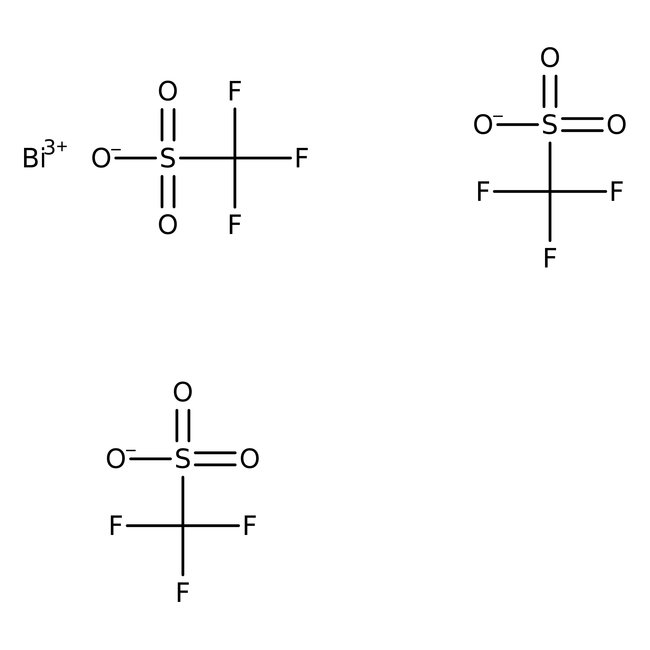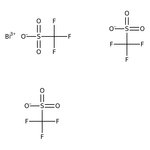Search Thermo Fisher Scientific
Thermo Scientific Chemicals
Bismuth(III) trifluoromethanesulfonate, 99%
CAS: 88189-03-1 | C3BiF9O9S3 | 656.17 g/mol
Catalog number ALFL19687.14
Price (MYR)
1,754.00
EA
Quantity:
25 g
Price (MYR)
1,754.00
EA
Specifications
Chemical Name or MaterialBismuth(III) trifluoromethanesulfonate
CAS88189-03-1
Health Hazard 1H314
Health Hazard 2GHS H Statement
H314-H318
Causes severe skin burns and eye damage.
Causes serious eye damage.
H314-H318
Causes severe skin burns and eye damage.
Causes serious eye damage.
Health Hazard 3P260-P264b-P280-P301+P330+P331-P303+P361+P353-P304+P340-P305+P351+P338-P310-P363-P501c
View more
Bismuth(III) trifluoromethanesulfonate acts as a catalyst in Friedel-Crafts acylation and cycloisomerization of allene-enol ethers. It behaves as a direct substitution catalyst and involved in the substitution of allylic, propargylic, and benzylic alcohols with sulfonamides, carboxamides and carbamates. Further, it is also used in Mukaiyama aldol reactions.
This Thermo Scientific Chemicals brand product was originally part of the Alfa Aesar product portfolio. Some documentation and label information may refer to the legacy brand. The original Alfa Aesar product / item code or SKU reference has not changed as a part of the brand transition to Thermo Scientific Chemicals.
Applications
Bismuth(III) trifluoromethanesulfonate acts as a catalyst in Friedel-Crafts acylation and cycloisomerization of allene-enol ethers. It behaves as a direct substitution catalyst and involved in the substitution of allylic, propargylic, and benzylic alcohols with sulfonamides, carboxamides and carbamates. Further, it is also used in Mukaiyama aldol reactions.
Solubility
Soluble in organics acetonitrile, dioxane, dimethyl formamide and dimethyl sulfoxide.
Notes
Hygroscopic. Incompatible with strong oxidizing agents.
Bismuth(III) trifluoromethanesulfonate acts as a catalyst in Friedel-Crafts acylation and cycloisomerization of allene-enol ethers. It behaves as a direct substitution catalyst and involved in the substitution of allylic, propargylic, and benzylic alcohols with sulfonamides, carboxamides and carbamates. Further, it is also used in Mukaiyama aldol reactions.
Solubility
Soluble in organics acetonitrile, dioxane, dimethyl formamide and dimethyl sulfoxide.
Notes
Hygroscopic. Incompatible with strong oxidizing agents.
RUO – Research Use Only
General References:
- Mild Lewis acid catalyst for high-yield acylation of alcohols: Angew. Chem. Int. Ed., 39, 2877 (2000), and Friedel-Crafts acylation of aromatics, effective at 5-10 mol%: Tetrahedron Lett., 38, 8871 (1997); Eur. J. Org. Chem., 2743 (1998). For use in the Claisen rearrangement of allyl ethers and the Fries rearrangement of phenyl esters, see: Synth. Commun., 34, 1433 (2004); Synlett, 2794 (2004); Tetrahedron Lett., 47, 4051 (2006). Aromatic sulfonylation can also be effected with sulfonyl chlorides: J. Org. Chem., 64, 6479 (1999). At 0.1-0.5 mol%, catalyzes the acylation of primary and secondary alcohols with anhydrides in high yield under mild conditions: J. Org. Chem., 66, 8926 (2001); see also Synthesis, 2091 (2001). For a review of acylation and sulfonylation reactions, see: Synlett, 181 (2002).
- Promotes the rearrangement of aryl-substituted epoxides to aldehydes and ketones: Tetrahedron Lett., 42, 8129 (2001). Catalyzes the deprotection of acetals and ketals under mild conditions: J. Org. Chem., 67, 127 (2002), and also the rapid cleavage of thioacetals: Tetrahedron Lett., 44, 2857 (2003). Catalyzes the allylation of aldehydes with Allyl tri-n-butyl tin, L14087, to give homoallylic alcohols: Synlett, 1694 (2002); J. Org. Chem., 70, 2091 (2005), and of acetals with Allyl trimethyl silane, A14662, providing a mild and efficient route to homoallyl ethers: Tetrahedron Lett., 43, 4597 (2002).
- Catalyzes the Michael-type addition of a variety of primary and secondary aliphatic amines to ɑ,ß-unsaturated compounds (acrylates, etc.) to give the saturated amino derivatives: Synlett, 720 (2003).
- The Ritter reaction of various nitriles with tert-alcohols to give tert-alkyl amides has been accomplished in high yield in the presence if a cataytic acmount of Bi(OTf)3: Tetrahedron Lett., 47, 8699 (2006).



